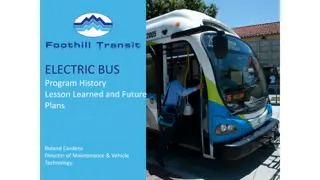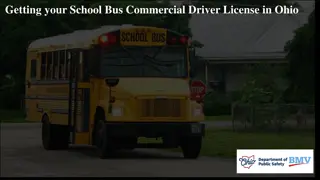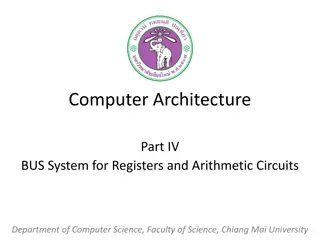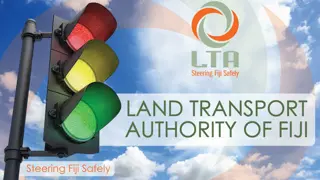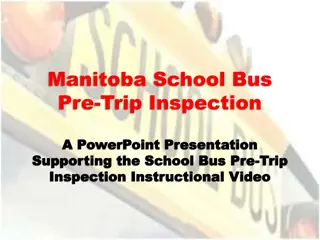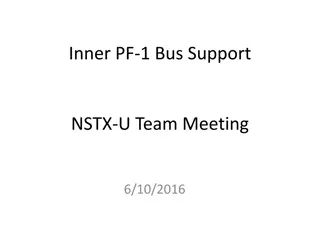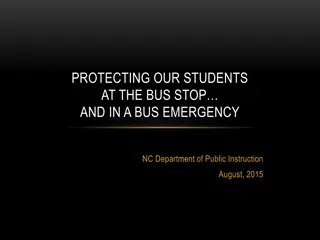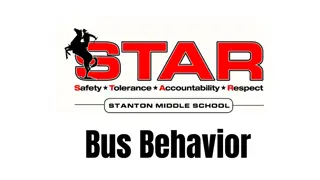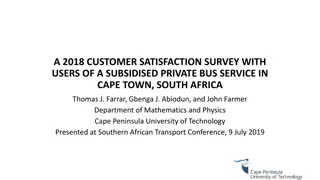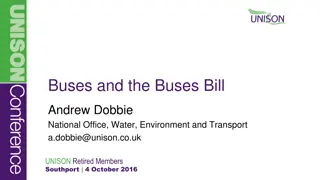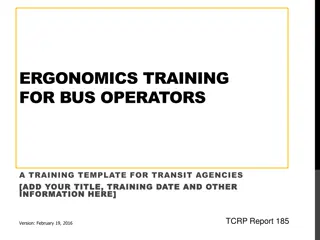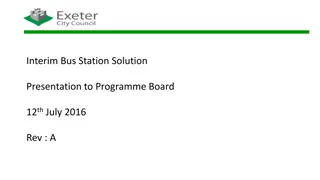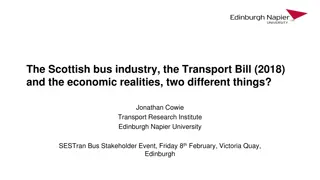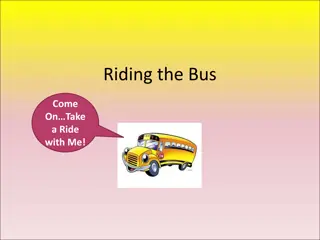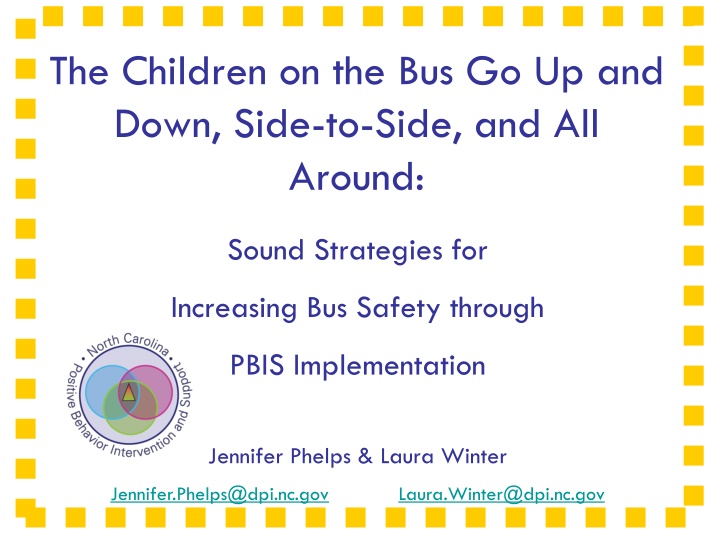
Strategies for Enhancing Bus Safety and Discipline with PBIS Implementation
Discover effective strategies implemented by PBIS schools in North Carolina to address discipline issues on school buses, reduce office discipline referrals, and create a safer commuting environment. Learn about problem-solving models, precise problem statements, goal setting, solution implementation, and action plans to improve bus safety.
Download Presentation

Please find below an Image/Link to download the presentation.
The content on the website is provided AS IS for your information and personal use only. It may not be sold, licensed, or shared on other websites without obtaining consent from the author. If you encounter any issues during the download, it is possible that the publisher has removed the file from their server.
You are allowed to download the files provided on this website for personal or commercial use, subject to the condition that they are used lawfully. All files are the property of their respective owners.
The content on the website is provided AS IS for your information and personal use only. It may not be sold, licensed, or shared on other websites without obtaining consent from the author.
E N D
Presentation Transcript
The Children on the Bus Go Up and Down, Side-to-Side, and All Around: Sound Strategies for Increasing Bus Safety through PBIS Implementation Jennifer Phelps & Laura Winter Jennifer.Phelps@dpi.nc.gov Laura.Winter@dpi.nc.gov
Introduction PBIS schools in North Carolina are seeing amazing decreases in Office Discipline Referrals during the school day, but continue to struggle with discipline issues on buses. Effective bus procedures that have reduced bus discipline issues and safety concerns by PBIS schools are presented. Strategies that can be implemented to provide safer bus commutes, decreased bus referrals, and increased positive acknowledgement for students are shared here.
Problem Solving Model Meeting Foundations Newton, J.S., Todd, A. W., Horner, R.H., Algozzine, B., & Algozzine K., 2010
In 2010-2011 school year, the PBIS team at Gamewell Elementary School noticed a high number of incidents of problem behavior occurring on the bus. Nearly 40% of all office referrals were bus related. 35% of all office referrals were on one bus. Of all the referrals related to the bus, 38% came from one grade level. Identify Problem
Precise Problem Statement 40% of all office referrals are bus related, with 35% of all office referrals related to one bus. Of all the bus related referrals, 38% came from one grade level. Develop Hypothesis
Creating a Goal 6 Decrease number of ODRs on all buses by half by the end of the school year. Discuss and Select Solutions
Designing Solutions Prevent Precorrect students during dismissal time in the bus loading zone. Reinforce behavior during bus loading zone in order to set tone for bus ride. Teach Post bus expectations on all buses. Reteach bus expectations to all students who ride buses; have identified grade level help teach expectations to younger students. Respond Each bus can earn a magnetic paw for obeying safety rules and having no discipline referrals per week. By the end of the nine-week grading period, each bus with at least seven paws receives a reward from the Assistant Principal. Discuss and Select Solutions
Action Plan Precise Problem Statement Responsible Person(s) Solutions Date Due Goal 40% of all office referrals are bus related, with 35% of all office referrals related to one bus. Of all the bus related referrals, 38% came from one grade level. 1.Reteach bus expectations to all students who ride the buses 2. Post bus expectations on each bus 3. Create magnetic paws 4. Collect paw data on all buses 1. AP and drivers 2. AP 3. Counselor 4. Counselor 1. First week of school 2. By beginning of school year 3. First week of school 4. By end of August Decrease number of ODRs on all buses by half by the end of the school year. Develop and Implement Action Plan
Results Rate of Bus Referrals per Month 7 6 5.9 5 4 3 2.6 2.5 2 1 0 2010-2011 2011-2012 2012-2013* (Two months) *Number of bus referrals decreased by 55% in one year. In 2011-2012, six of eight buses consistently earned 7+ paws per 9-weeks.
Evaluate and Revise Action Plan Steps for Evaluation 1. Determine if behavior has improved. 2. If yes, choose one of the following options: Modify criteria for mastery Choose another behavior to address End individualized plan 3. If not, choose one of the following options: Evaluate fidelity of implementation Evaluate and Revise Action Plan Re-evaluation function Find ways to adjust the plan
Acknowledgements Thanks to Gamewell Elementary School in Caldwell County, North Carolina for sharing their data, expertise, and Best Behaved Bus presentation. Also, thanks to Wake County Schools for their original creation of the PBIS on the Bus brochure; based on Randy Sprick s In the Driver's Seat: A Roadmap to Managing Student Behavior on the Bus.
Bus Driver Training Invite all drivers to the school after the morning routes are completed for a light breakfast and brief workshop. Present each driver with a packet that contains a copy of the expectations for the bus (to be displayed on the bus), the PBIS on the Bus pamphlet, and a bank of the school s reinforcements. Collaborate with the drivers about how to encourage positive behavior on the bus, given the tools provided. Ideally, this would be done system-wide, to ensure consistency.
Pre-Dismissal Strategies Many schools overlook the importance of the role the school plays in preparing the children for positive behavior on the bus. Allow ample time for dismissal so that children do not feel rushed. Create a reinforcement system for the bus loading area that is connected to the school-wide plan and is contingent upon meeting expectations while waiting to board the bus. Each bus earns points for the behavior in the bus loading zone, and at the end of the week, the bus with the most points gets a small treat.


